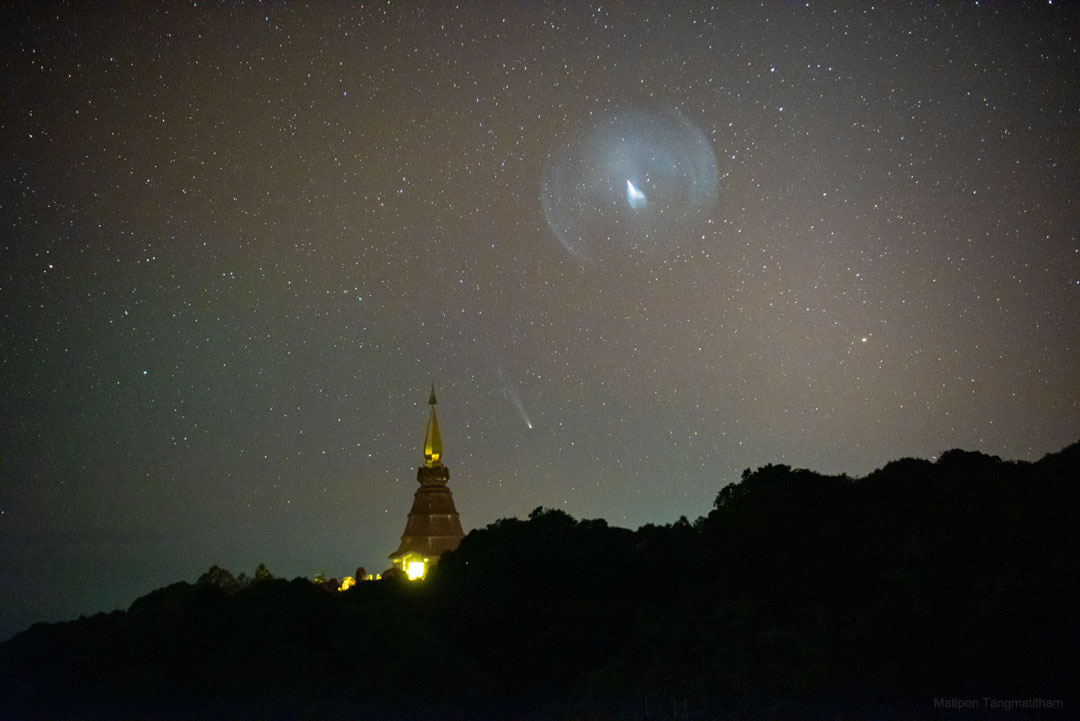© Stocklady, Shutterstock
Nombre total de pages vues
28/12/2021
ART FRACTAL - Et design - © Stocklady, Shutterstock
ASTRONOMY - Sun Halo over Sweden
2021 December 28
Video Credit & Copyright: Håkan Hammar (Vemdalen Ski Resort, SkiStar)
Explanation: What's happened to the Sun? Sometimes it looks like the Sun is being viewed through a giant lens. In the featured video, however, there are actually millions of tiny lenses: ice crystals. Water may freeze in the atmosphere into small, flat, six-sided, ice crystals. As these crystals flutter to the ground, much time is spent with their faces flat and parallel to the ground. An observer may find themselves in the same plane as many of the falling ice crystals near sunrise or sunset. During this alignment, each crystal can act like a miniature lens, refracting sunlight into our view and creating phenomena like parhelia, the technical term for sundogs. The featured video was taken in late 2017 on the side of a ski hill at the Vemdalen Ski Resort in central Sweden. Visible in the center is the most direct image of the Sun, while two bright sundogs glow prominently from both the left and the right. Also visible is the bright 22 degree halo -- as well as the rarer and much fainter 46 degree halo -- also created by sunlight refracting through atmospheric ice crystals.
MINERAUX - Le gypse
27/12/2021
MICROPHOTOGRAPHIE - Marek Mis - Un labyrinthe de formes géométriques
MUSIC - Elgar Nimrod - Daniel Barenboim & Chicago Symphony Orchestra - Enigma variations
ASTRONOMY - Comet Leonard behind JWST Launch Plume
2021 December 27
Image Credit & Copyright: Matipon Tangmatitham (NARIT)
Explanation: Which one of these two streaks is a comet? Although they both have comet-like features, the lower streak is the only real comet. This lower streak shows the coma and tail of Comet Leonard, a city-sized block of rocky ice that is passing through the inner Solar System as it continues its looping orbit around the Sun. Comet Leonard has recently passed its closest to both the Earth and Venus and will round the Sun next week. The comet, still visible to the unaided eye, has developed a long and changing tail in recent weeks. In contrast, the upper streak is the launch plume of the Ariane V rocket that lifted the James Webb Space Telescope (JWST) off the Earth two days ago. The featured single-exposure image was taken from Thailand, and the foreground spire is atop a pagoda in Doi Inthanon National Park. JWST, NASA's largest and most powerful space telescope so far, will orbit the Sun near the Earth-Sun L2 point and is scheduled to start science observations in the summer of 2022.
26/12/2021
MICROPHOTOGRAPHIE - Marek Mis - Alliance d’un médicament et d’un additif alimentaire
25/12/2021
MINERAUX - La crocoïte
ASTRONOMY - The Tail of a Christmas Comet
Image Credit & Copyright: Rolando Ligustri (CARA Project, CAST) and Lukas Demetz
Explanation: The tail of a comet streams across this three degree wide telescopic field of view captured under dark Namibian skies on December 21. In outburst only a few days ago and just reaching naked eye visibility Comet Leonard (C/2021 A1) is this year's brightest comet. Binoculars will make the diffuse comet easier to spot though, close to the western horizon after sunset. Details revealed in the sharp image show the comet's coma with a greenish tinge, and follow the interaction of the comet's ion tail with magnetic fields in the solar wind. After passing closest to Earth on December 12 and Venus on December 18, Comet Leonard is heading toward perihelion, its closest approach to the Sun on January 3rd. Appearing in late December's beautiful evening skies Comet Leonard has also become known as 2021's Christmas Comet.
SANTé/MEDECINE - CANCER - 12 AVANCEES REVOLUTIONNAIRES - 9. Un traitement du cancer du col de l’utérus qui réduit drastiquement la mortalité
Une étude internationale appelée INTERLACE, menée dans 5 pays, a démontré qu’un cycle de chimiothérapie avant le traitement classique du can...
/https%3A%2F%2Flanature.ca%2Fapp%2Fuploads%2F2025%2F04%2Ffreepik__adjust__26120.jpeg)
-
2022 September 26 All the Water on Planet Earth Illustration Credit: Jack Cook, Adam Nieman, Woods Hole Oceanographic Institution ; Data ...
-
2025 May 11 The Surface of Venus from Venera 14 Image Credit: Soviet Planetary Exploration Program , Venera 14 ; Processing & Copyri...







